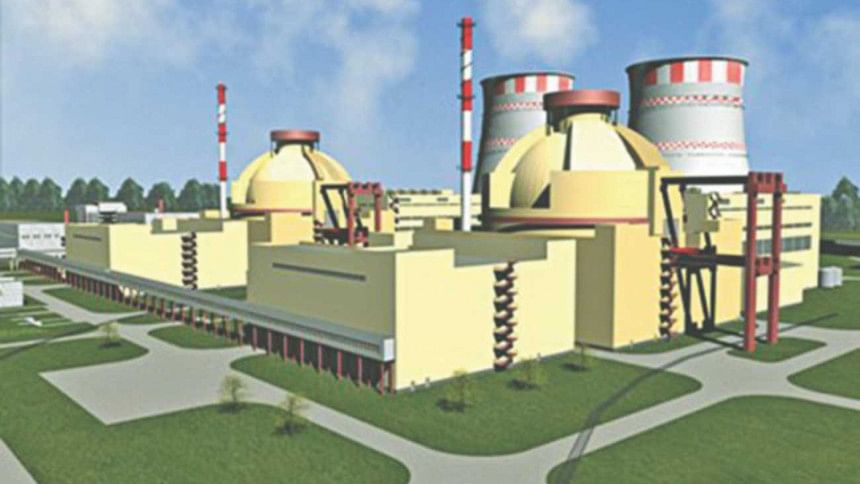The economics of the Rooppur Nuclear Power Plant

The contracted price for the 2,400 MWe Rooppur Nuclear Power Plant, consisting of two Russian VVER-1200 reactors, is USD 12.65 billion. If we add USD 550 million, which we already spent for the project, the total price comes to USD 13.2 billion. This is a big sum of money, enough to build four Padma bridges! Is it reasonable? For comparison of power plants of different sizes, it is convenient to quote the price on per unit (kWe) basis. USD 13.2b for 2,400 MWe comes to USD 5,500/kWe on this basis.
In 2009, I advised the Bangladesh Atomic Energy Commission (BAEC) at a roundtable conference organised by The Daily Star to build two generation-III nuclear reactors, each of 1,000 MWe, at Rooppur. It was expected that the plant would be operational by 2018-19. Based on the experience of two similar reactors (VVER-1000) being built by the Russians at Kudankulam (Units 1 and 2) in India at that time, I estimated that the cost for a nuclear plant at Rooppur would not exceed USD 2,000/kWe. It may be mentioned here that the construction of the Kudankulan Units 1 and 2 started in 2002, and actually cost USD 1,300/kWe.
Unfortunately, there was very little activity on the Rooppur project until 2013 when BAEC signed several agreements with the Russians for a feasibility study and for site preparations. As a matter of fact, BAEC should have undertaken a large-scale programme of recruitment, and training of engineers in 2009, as suggested at the roundtable, and developed expertise in this field. They missed this opportunity due to their inexperience in dealing with nuclear power projects. We are now paying a heavy price for their mistake. We cannot blame the BAEC alone as it lost its autonomy with time and all decisions on Rooppur are now taken by the Ministry of Science and Technology.
After the disastrous nuclear accident at Fukushima in 2011, many countries, particularly in Europe, decided to phase out nuclear power plants. Russia, China and India, on the other hand, continued with nuclear power but incorporated new safety features in the designs that increased the cost of the power plants significantly. For example, the cost of two new VVER-1000 reactors at Kudankulam (Units 3 and 4) increased from USD 1,300/kWe to USD 3,000/kWe. The construction of the units 3 and 4, by the way, started in February 2016.
Because of the delay in preparation of the feasibility study, I suggested in March 2013 to consider two VVER-1200 reactors, instead of two VVER-1000 reactors, for Rooppur. My suggestion was based on several factors. (i) Because of the delay, the Rooppur nuclear plant was unlikely to be operational before 2023 when a 1,200 MWe reactor could be safely integrated into the grid. The per unit capital cost (i.e. USD/kWe) of a larger nuclear plant is usually lower than that of a smaller plant because of the economies of scale. (ii) The VVER-1200 plant incorporates modular and compact design intended to substantially reduce the plant cost and construction time. (iii) The VVER-1200 reactors have better safety features than the VVER-1000 reactors.
BAEC finally decided to buy two VVER-1200 reactors but its price tag of USD 5,500/kWe was shocking. For reasons explained above, I didn't expect the price to be much higher than USD 3,000/kWe. Considering the additional costs for cooling towers and complex foundations due to poor soil conditions at Rooppur, the price could perhaps reach $4,000/kWe but no more. A price tag of USD 5,500/kWe is simply unreasonable and unacceptable.
We are paying this price because our negotiators didn't have the expertise to properly scrutinise the quoted price. If we build two nuclear plants of the same type, one in Europe and another in Bangladesh or India, the one in our region will cost much less due to our lower material and labour costs. We normally break the cost of power plants into three components, namely, (i) equipment cost, (ii) material cost and (iii) labour cost. The equipment cost is usually the same, irrespective of the location of the plant. The costs of material and labour vary from place to place and need adjustments. If we know the equipment cost, material cost and labour cost of a plant in Europe, we can easily estimate its likely cost in our region by multiplying the material and labour costs by appropriate indices as is done in ORCOST or similar computer codes for estimation of capital costs of power plants. For our region, the indices are significantly less than 1. This makes the plants much cheaper here.
India, with its expertise in this field, successfully negotiated a reasonable price for the Kudankulam Nuclear Plant. Our seemingly inexperienced negotiators failed to do so, and hence we are now paying a much higher price. They negotiated in unusual hurry, without hiring any independent consultant and without taking any assistance from the local experts who have the experience of similar negotiations.
What are our options now? It may not be too late to renegotiate the price by adjusting the material and labour costs of the project as suggested above. We can use local workers and local materials like steel, cement, shingles, etc and thus reduce the cost of construction and erection significantly. We can also use locally manufactured electrical cables, sanitary wares, tiles, etc to further reduce the cost. If we can renegotiate skilfully, there is no reason why the price should not come down to the level of USD 4,000/kWe or less. This will save at least USD 3.6b, enough to build another Padma ot Jamuna bridge.
The other option is to discard VVER-1200 reactors and build VVER-1000 reactors like India is doing. Even if we pay a price of USD 4,000/kWe, which is much higher than the Indian price of USD 3,000/kWe, we can still build three 1,000 MWe reactors at Rooppur with a total capacity of 3,000 MWe for USD 12b only. In this case, we shall get 600 MWe more power by paying USD 1.2b less.
Renegotiation of a contract is not easy but worth trying since the stakes are very high. It can perhaps be done if the issue is taken seriously by the government and discussed with Russia at the highest level.
The writer is a retired nuclear engineer, former Professor of BUET and author of Nuclear Power & Rooppur.

 For all latest news, follow The Daily Star's Google News channel.
For all latest news, follow The Daily Star's Google News channel. 



Comments